Matale is northern – most district of the Central Province. The district’s current population is over 400,000 and the main cities are Matale, Dambulla, Galewela and Rattota. Agriculture remains the main income source of this region with paddy being the primary commercial crop. In addition, minor export crops and vegetables are also grown in the district, while several large-scale tea factories continue to be operational. The district is enriched with many natural resources and minerals such as chan kite, mica, ceramic, gems, lime and granite.
The district is home to the Knuckles mountain range, which is considered as a national heritage due to its rich biodiversity and geographical characteristics. Laggala in the eastern boundary is renowned for the three mountain ranges that run parallel to each other, along with the ‘Small World’s End’ located in Pitawala for its bird’s-eye view into the valley below. Several mountain peaks with a historical significance such as Sigiriya, Dambulla and Beliyakanda, lie in the northern flat lands of Matale.
Matale experiences both North-East and South –West monsoons, the former bringing the heavier showers. Sugu Ganga, which winds through the city of Matale adding to its natural beauty, symbolizes the rich water resources of this region. Kandalama and Dewahuwa are two major tanks of the district, while Inamaluwa, Talkote and Sigiriya are minor tanks. In addition, the Kalawewa and Minneriya tanks in the North Central Province are fed by tributaries originating from peaks of the Matale District.
Historical and natural attractions scattered across the district such as Sigiriya, Dambulla Cave Temple, Aluvihare, Kawatayamuna Temple, Sri Muthumari Amman Kovil, St Anthony’s Church- Wahakotte, Nalanda Gedige, Lakegala, Ibbankatuwa Magalithic Tombs, Knuckles Mountain Range and Wasgamuwa National Park offer travelers the opportunity to explore the culturally vibrant history of the island.
Sigiriya
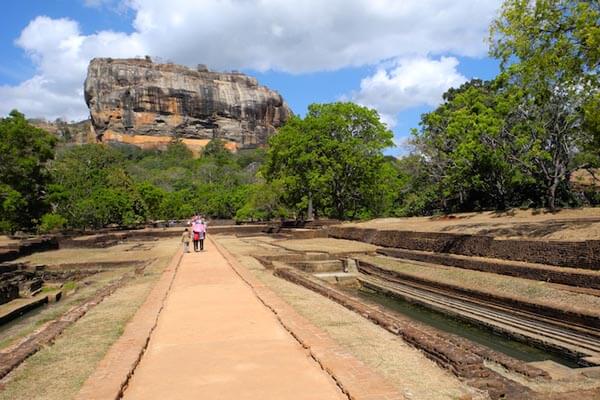
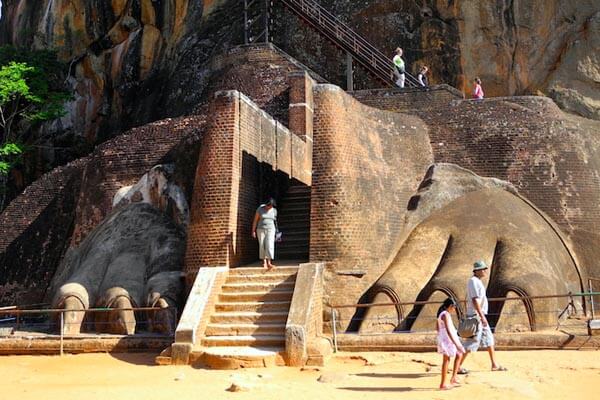
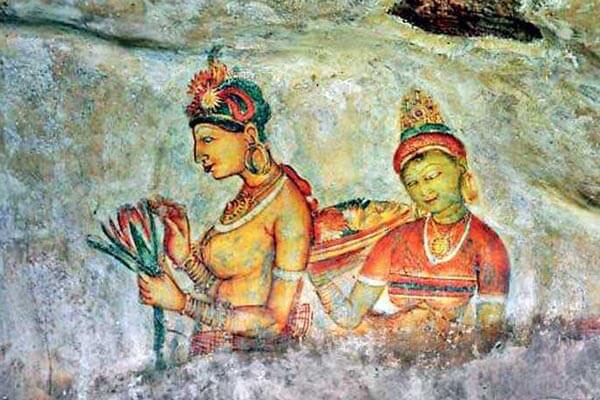
The Cultural Triangle Project, launched by the Government of Sri Lanka, focused its attention on Sigiriya in 1982. Archaeological work began on the entire city for the first time under this project. There was a sculpted lion’s head above the legs and paws flanking the entrance, but the head had broken down many years ago. Sigiriya consists of an ancient castle built by King Kassapa during the 5th century. However, the beginnings and the original builder of Sigiriya is challenged by many local and foreign historians and archaeologists. The Sigiriya has the leftovers of an upper palaces on the flat top of the rock, a mid level terrace including the Lion Gate and the mirror wall with its frescoes, the lower palace that clings to the slopes below the rock; the moats, walls, and gardens extending for some hundreds of metres out from the base of the rock. It is both a palace and a fortress. Despite its age, the splendor of the palace still furnishes a stunning insight into the ingenuity and creativity of its builders. The upper palace on the top of the rock includes cisterns cut into the rock that still retain water. The moats and walls that surround the lower palace are still gracefully attractive.
Mirror wall made of some kind of porcelain, the wall is now partially covered with verses scribbled by visitors to the rock. The mirror wall is well preserved. Some historians and archaeologists state that the verses date from the 8th century but there are many who challenge it. People of all types wrote on the wall, on varying subjects such as love, irony, and experiences of all sorts. Further writing on the mirror wall has now been banned. The most important aspects of Sigiriya are the gardens and it is among the oldest landscaped gardens in the world. The gardens are divided into three distinct but linked forms: water gardens, cave and boulder gardens, and terraced gardens.
The water gardens are seen in the central section of the western gardens. Three principle gardens are found here. The first garden consists of a plot surrounded by water. It is connected to the main precinct using four causeways, with gateways placed at the head of each causeway. This garden is built according to an ancient garden form and is one of the oldest surviving models of this form. The second contains two long, deep pools set on either side of the path. Two shallow, winding streams lead to these pools. Fountains made of circular limestone plates are placed here. Underground water conduits supply water to these fountains which still function, especially during the rainy season. Two large islands are located on either side of the second water garden. Summer palaces are built on the flattened surfaces of these islands. Two more islands are located farther to the north and south, in a manner similar to the island in the first water garden.
DAMBULLA
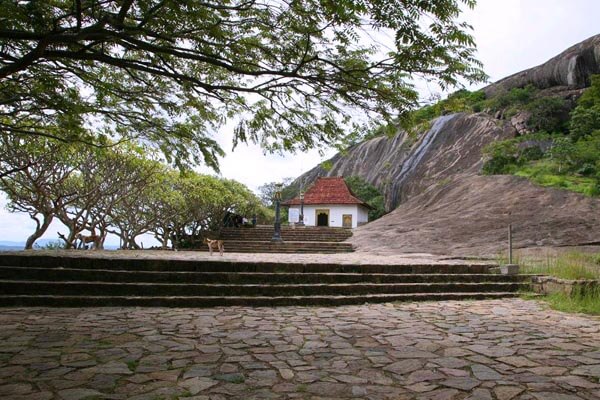
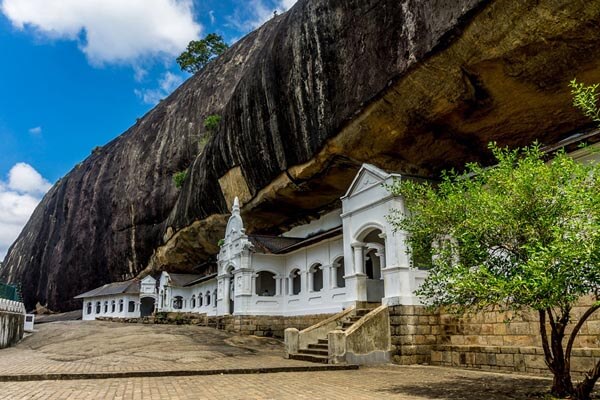
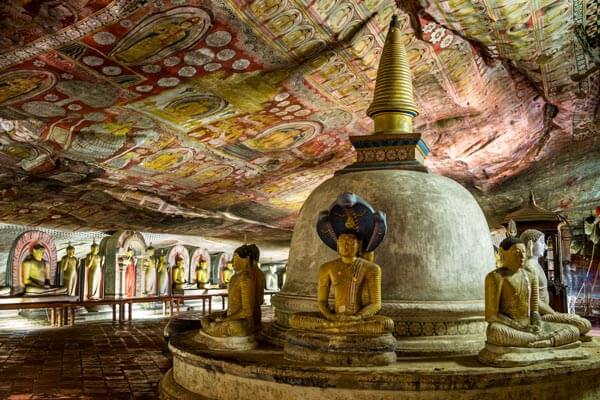
Dambulla is part of the Cultural Triangle. It houses the gigantic Dambulla Cave Temple declared a UNESCO World Heritage site. The Dambulla caves date back to 1st century BCE. Originally it was the refuge of King Walagamba, and caves were later converted into a rock temple. It houses beautiful frescoes and an imposing 15-metre long reclining Buddha and Hindu deities. The caves are considered to be the finest storehouse of Sinhala art and sculpture. It has five caves under a vast overhanging rock, carved with a drip ledge to keep the interiors dry. In 1938 the architecture was inflated with arched walkways. Inside the caves, the ceilings are painted with complex patterns of religious images following the contours of the rock. There are images of Lord Buddha, and Bodhisattvas, as well as various gods’ goddesses. Five caves are converted to shrine rooms. The caves, built at the base of a 150 metre high rock during the Anuradhapura (1st Century BCE to 993 AD ) and Polonnaruwa times (1073 to 1250 AD), are the most inspiring of many cave temples in Sri Lanka.
The largest cave measures about 52 metres from east to west, and 23 metres from the entrance to the back, this amazing cave is 7 metres tall at its highest point. Hindu deities are also represented here, and the kings Walagamba, Nissankamalla, and of Arhant Ananda; the Buddha’s most devoted disciple. Within these shrine rooms is housed a collection of one hundred and fifty statues of the Buddha’s most devoted disciple. Within these shrine rooms is housed a collection of one hundred and fifty statues of the Buddhist Order and the country’s history. These statues and paintings represent many eras of Sinhala art and sculpture. The Buddha statues are in varying sizes and outlook; the largest is 15 metres long. One cave has over 1,500 paintings of the Buddha covering the ceiling. The Dambulla cave monastery is still functional and remains the best-preserved ancient structure in Sri Lanka. This complex dates from the 2nd and 3rd Centuries BCE; it was established as one of the largest and most important monasteries. King Walagamba converted the caves into a temple in the 1st century BCE. Exiled from Anuradhapura, he sought refuge here from South Indian invaders for 15 years. After reclaiming his capital, the King built a temple in thankful worship. Many other kings added to it later and by the 11th century, the caves had become a major religious centre. King Nissankamalla gilded the caves and added about 70 Buddha statues in 1190 AD. During the 18th century, the caves were restored and painted by the Kandyan Kings. A hike to the highest Rose Quartz Mountain Range in South Asia offers the pleasure of a striking view of the neighboring area for miles around. With a history spanning over 1,000 years, Jathika Namal Uyana, also known as the Ironwood Forest, offers a fascinating trek through a deep jungle comprising of the Sri Lankan national tree, the Na (Iron wood). The forest is of important ecological extent and is the focus of studies by ecologists and students of nature.
RIVERSTON
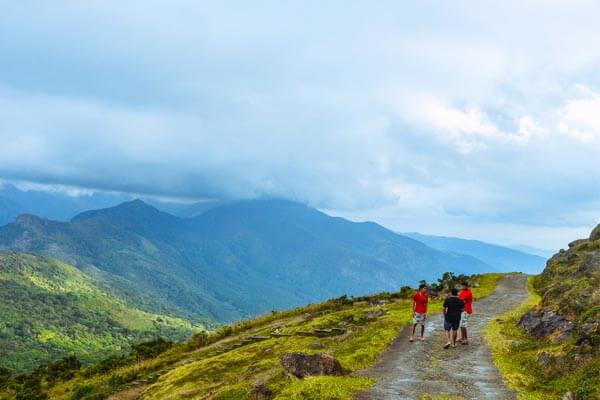
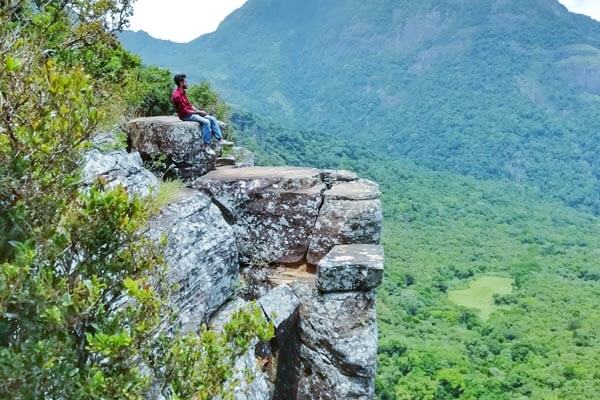
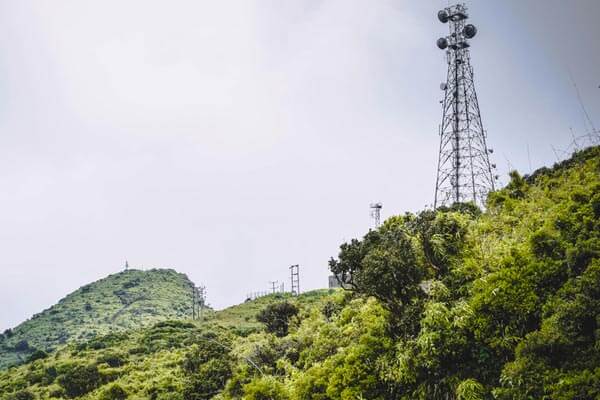
The Riverston plain can be reached by travelling approximately 30 kilometers away from the Matale town, along the Matale town-Girandurukotte Road. This decretive and winding road, with its sharp hairpin bends, offers some of the best views of the surrounding countryside. Sprawling across the Knuckles forest reserve, riverston borders the wet zone on the South West, and the dry zone on the East. As a result, the plain undergoes a range of climatic shift and facilitates a vast array of flora and fauna within 180 square kilometers.
The trek along Riverston is currently measured at two and a half kilometers (one way), and would take roughly two hours at most to complete. The scenic trek runs through the ‘Pitawala Paththana, ’which leads to the Riverston Peak and the Mini World’s end. The Riverston Peak features a sheer 300- meter drop to stunning misty views of the nearby knuckles mountain range and terraced paddy fields along the Thelgamu river valley. The Riverston trek crosses through two graceful waterfalls, namely the Sera ella and the Bambakiri ella. The nearby freshwater stream, the Thelgamu oya is perfect for quick cooling dip or even a refreshing splash before or after an arduous trek. With such peaceful and stunning surroundings, Riverston is a wonderful spot for mediation and relaxation, as well as an opportune location for nature lovers and photographers to embrace a range of captivating sights.
THELGAMU OYA
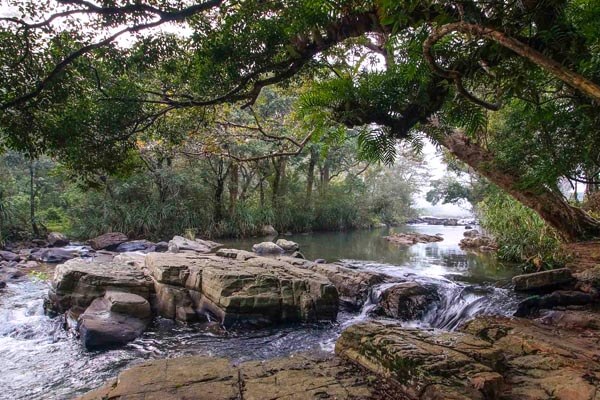
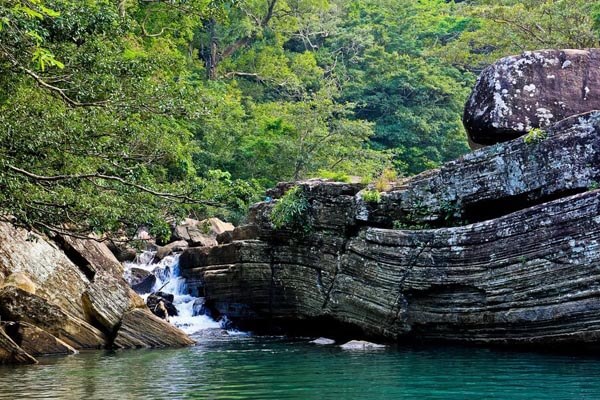
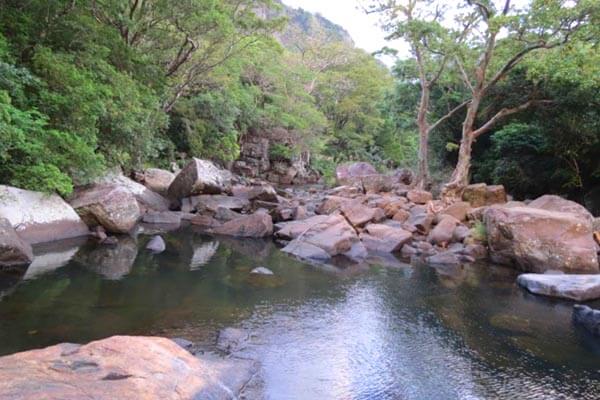
Thelgamu oya is a freshwater stream that flows from the knuckles mountain range. Originally called the ‘Dumbara range’, the name ‘Knuckles’ was attributed to the hills’ resemblance of Knuckles on a human fist. The Thelgamu stream is connected to a network of waterways that descend from this majestic mountain range. Thelgamu oya is a charming freshwater stream, with clean gushing water amidst a multitude of natural rock pools. A few of these pools are deep, while others are shallow, making them perfect for bathing or swimming. The deeper pools of are dangerous to swim in, but are home to a variety of freshwater fish.
Shady hollows are formed as the stream flows to a rhythmic flow beneath a pleasant foliage of trees. This setting makes Thelgamu oya a perfectly relaxing place to visit. Nevertheless, Knuckles protection officers complain that local tourists tend to oversee this relaxing appeal and pollute the pristine surroundings. It is a primary responsibility of all tourists to protect such natural attractions, while preserving them for future generations to come.
SERA ELLA
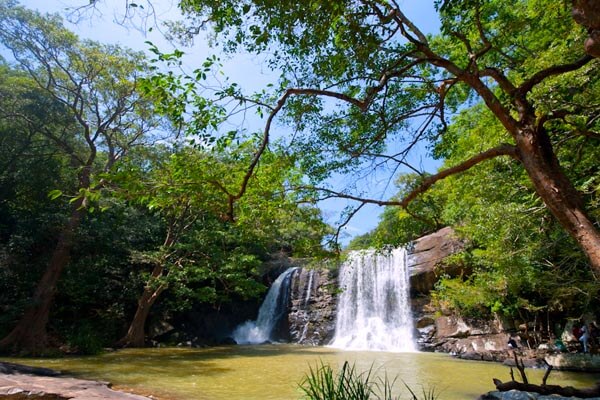
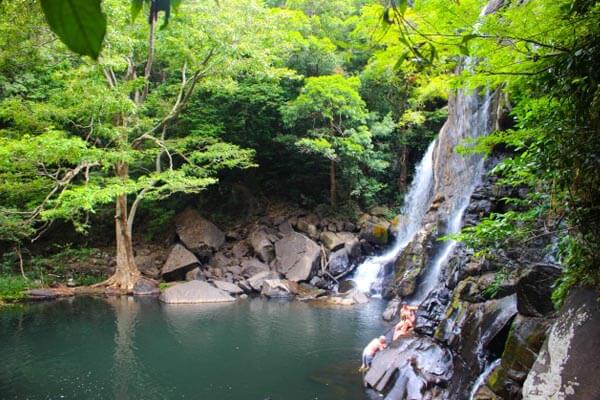
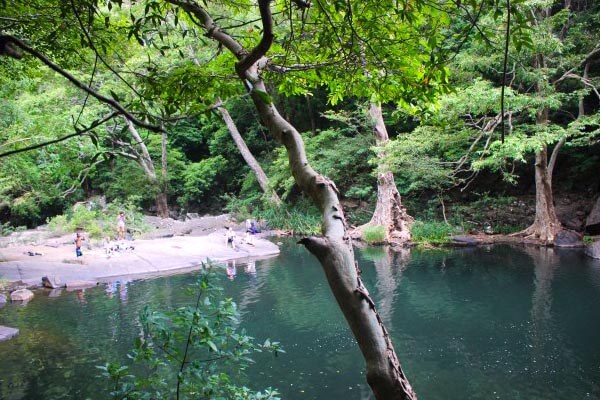
Located at the Eastern end of the Knuckles forest reserve, the Sera ella waterfall can be reached through the Matale Riverston trek, or via the Illukkumbura main road. 32 feet in height, the Sera ella originates from the Thelgamu oya and is considered to be one of the widest waterfalls in Sri Lanka.
A special feature of Sera ella is the rock cave situated behind the waterfall, that provides a unique view of the waterfall from inside out. Steps have been cut on the back- end of the rocky slope to reach the cave, which can be safely accessed even when the waterfall is at its fullest form. Sera ella flows all year around, but is at its fullest during the monsoon season between November and March. The name of the waterfall is derived from the ’sera’ species of fish inhabit the water. The Sera ella has been personified by many great local poets in their literary work, thus signifying the timelessness of a breathtaking and captivating natural wonder.
ALUVIHARAYA ROCK TEMPLE
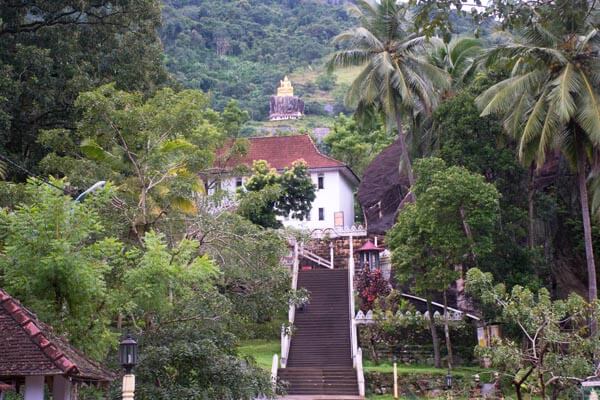
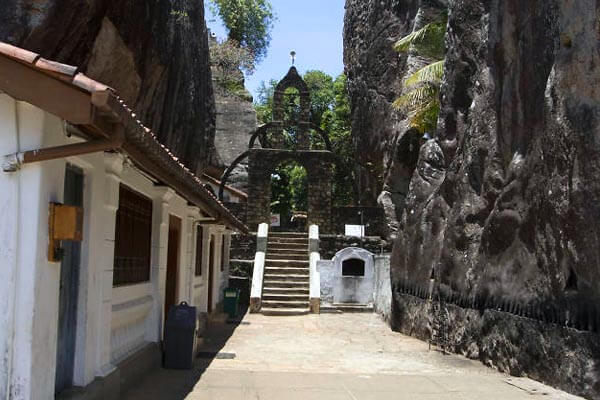
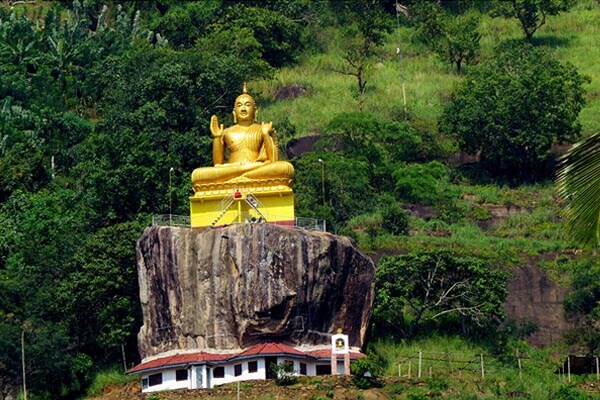
The Aluvihare rock temple holds a significant place in Sri Lankan Buddhist history. It is in this auspicious location that 500 Buddhist monks gathered and codified Lord Buddha’s teachings into three religious doctrines known as the “Tripitakas,’ during the reign of King Walagamba of Anuradhapura in 1st century BC. Until the Tripitakas were codified, all Buddhist teachings were meticulously passed down through many generations of Buddhist monks by word-of-mouth. The Tripitakas were originally written in Palm leaf of Ola leaf manuscripts, a tradition that has been carried forward by the temple of this date. Most monks from the Aluvihare temple specialize in palm leaf manuscript writing, a decadent art reminiscent of a rich local tradition.
The stately rock caves in the temple’s interior, once acted as the venue for the codification of the Tripitakas by ancient Buddhist monks. Today, the caves provide a commodious residence for present-day Bhikkhus residing in the temple. The caves also shelter a library filled with ancient manuscripts; timeless Buddha statues of terra cotta, marble and brass; and fascinating murals adorned with paintings of Jathaka stories. The stone ceilings of the caves are mostly covered by colorful Kandyan-era paintings. To this day, the Aluvihare rock temple symbolizes the rich religious and literary heritage that is omnipresent in Sri Lanka’s socio- cultural fabric.
SRI MUTHUMARIAMMAN KOVIL
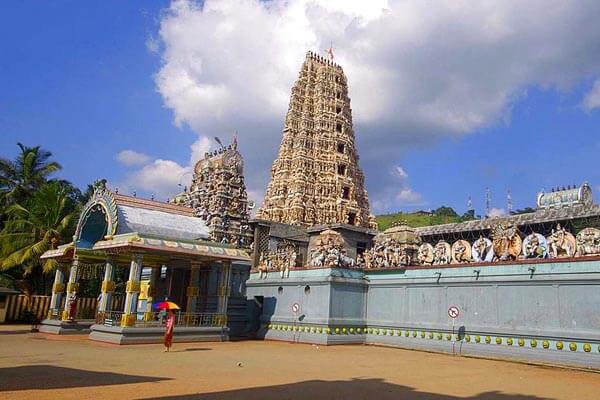
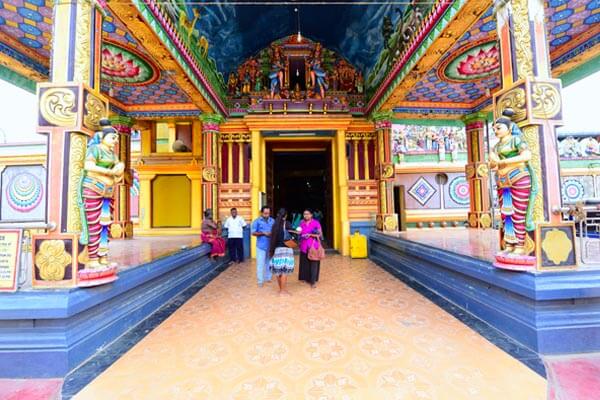
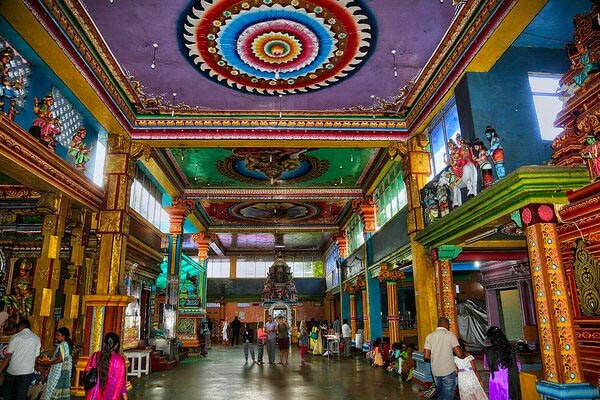
On the surface, there is little to see in the quaint town of Matale, yet hidden amidst the bustle of daily life is the Sri Muthumariamman temple complex; a haven for Hindu spirituality and devotion. The temple was constructed in 1816, and claims a proud history of 175 years. Built in the Dravidian architectural style, the Muthumariamman complex is the largest of its kind in the central province. The front pyramid of the temple stands at 108 feet and consists of 1008 colorful statues and murals. During times of prayer, the transcendent colours of the temple manifest a strinking symbiosis with the colorful fabrics adorned by faithful devotees.
As the name suggests, the temple is dedicated to Muthumariamman. The goddess Muthumariamman, also known as ‘Paththini’ is a significant deity among Hindus in India and Sri Lanka. The prefix ‘Muthu’, meaning “pearl”, is a honourific title, and “Amman” simply means, “Mother.”Hindus regard goddess Paththini as well-powerful deity capable of bringing prosperity and success to all. The best time to visit this symbolic temple is during the annual Theru festival in February and March. The festival marks the birthday of goddess ‘paththini.’ During this period, the entire temple complex is known to come alive with vibrant celebration.
WASGAMUWA NATIONAL PARK
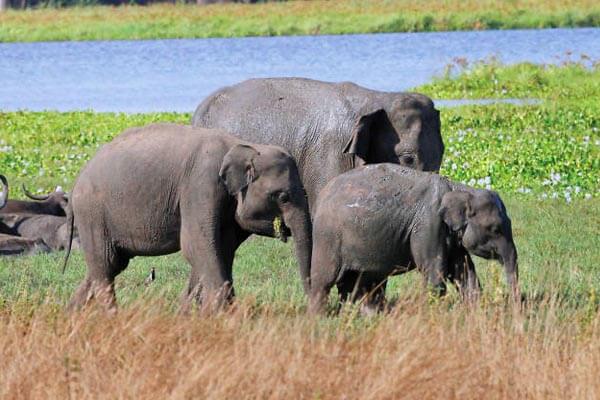
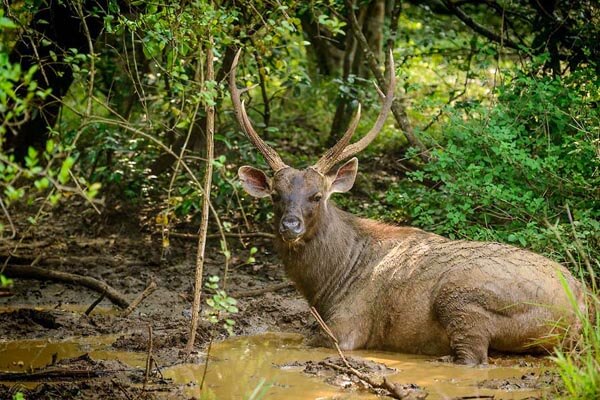
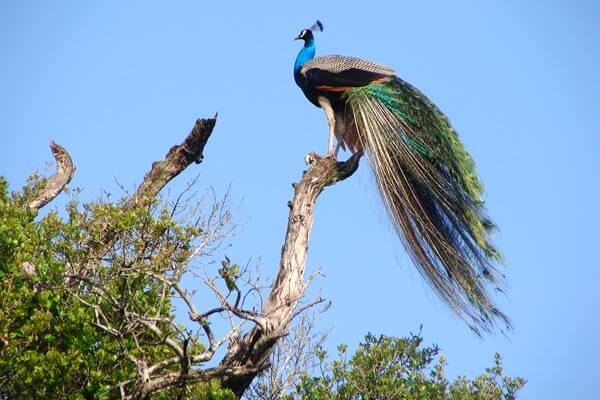
Albeit originally a nature reserve, Wasgamuwa was elevated to the status of a National Park in 1984, in order to provide a safe refuge for wildlife displaced as a result of the Mahaweli Development project. Sprawling across 393 square kilometers across both Matale and Polonnaruwa districts, the Wasgamuwa National Park reverberates with a rich history. For instance, the Malagamuwa, Wilmitiya, Dasthota irrigation tanks and the kalinga Yoda Ela built by Parakramabahu the 1st still remains to be seen within the park. Also found within the park is the “Yudangana Pitiya,” historically acknowledged as the site of the epic battle between King Elara and King Dutugemunu.
The park’s dry zone habitat is popular for sighting herds of Elephants, sometimes as many as 150 in each herd. The best time to sight elephants in the region is during the dry season in November and May, when they congregate in large groups near watering holes. Considered as a locale with high biodiversity, the Wasgamuwa National Park consists of 140 species of mammals such as the endemic purple –faced langur, the toque mancaque monkey, water buffalo, wild boar, sambhur, axis deer and the less frequently seen sloth bear and leopard. Adding to the wildlife splendor are 8 species of reptiles, 17 species of fish and 50 species of butterflies, of which eight are endemic. The number of bird species found here amounts to 143, of which, the endemic bird species include the Ceylon jungle fowl, Red faced malkoha, peafowl, painted stork, White necked stork, Black-headed ibis and the Eurasian spoonbill. Visitors to the park are faced with the unique choice of lodging within the park premises itself. The more adventurous tourists are allowed to camp out in selected areas of the park and gain a truly monumental experience in the wilderness.
NATIONAL SPICE GARDEN
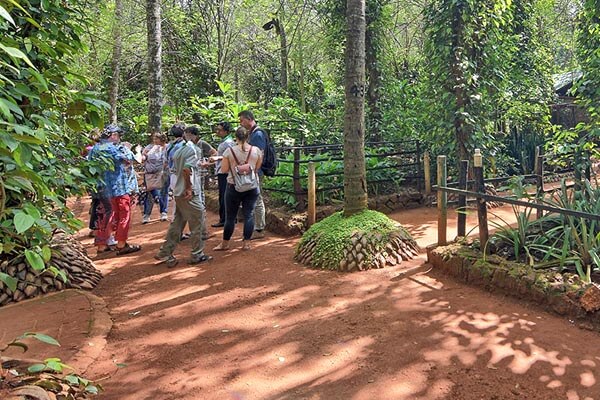
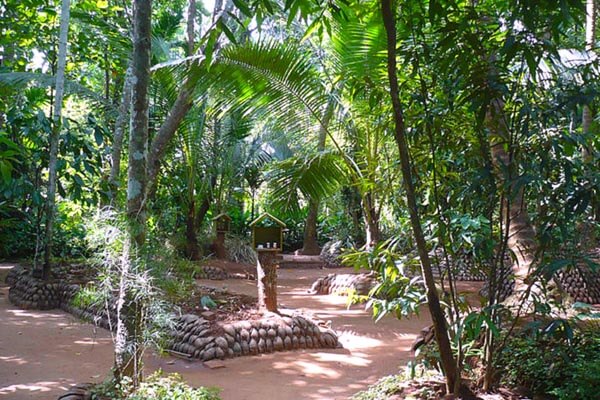
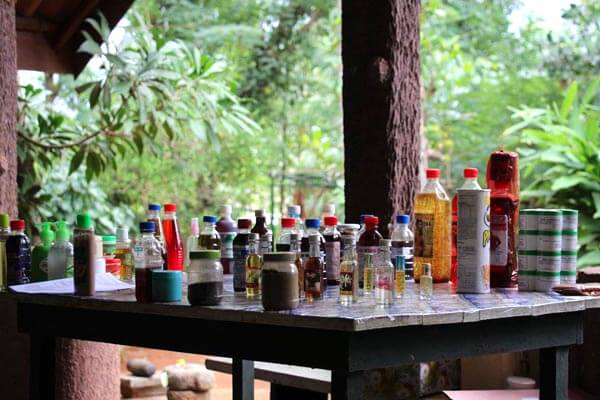
Matale is home to Sri Lanka’s first and largest National Spice Garden. Located in a scenic setting, the spice garden Provides a truly educational experience to local and foreign visitors alike. The National Spice Garden consists 20 spices from across the country. Black pepper, cardamom, cinnamon, cloves, ginger, nutmeg and turmeric are a few of the prominent spices witnessed in this location. A production center situated within the garden allows visitors to observe how these spices are grown, harvested and produced.
Historically, Sri Lanka was world renowned for its quality spices. Through the spice trade, ancient, Greeks, Romans and Arabs maintained significant links with Sri Lanka. Even today, the importation of spices generates significant revenue to the economy. However, in order to retain a competitive edge within the global market, it is important to preserve and promote the local spice industry through the establishment of such National Spice Garden across the island.
Matale District is a district in Central Province, Sri Lanka. Its area is 1,987 km². The administrative capital of the district is the city of Matale. Find travel attractions in Matale Sri lanka, with Sri lanka Dream Tours.
